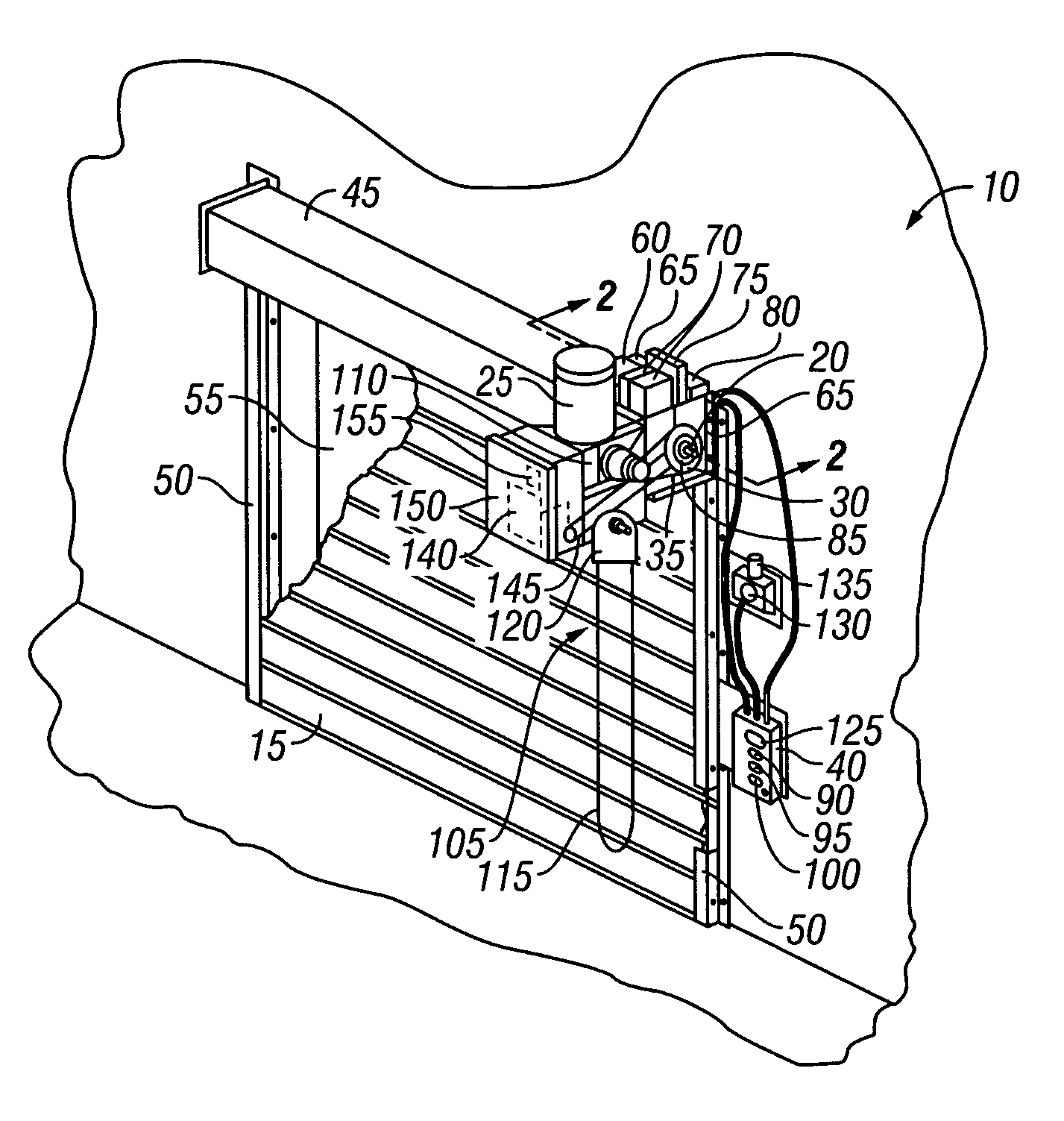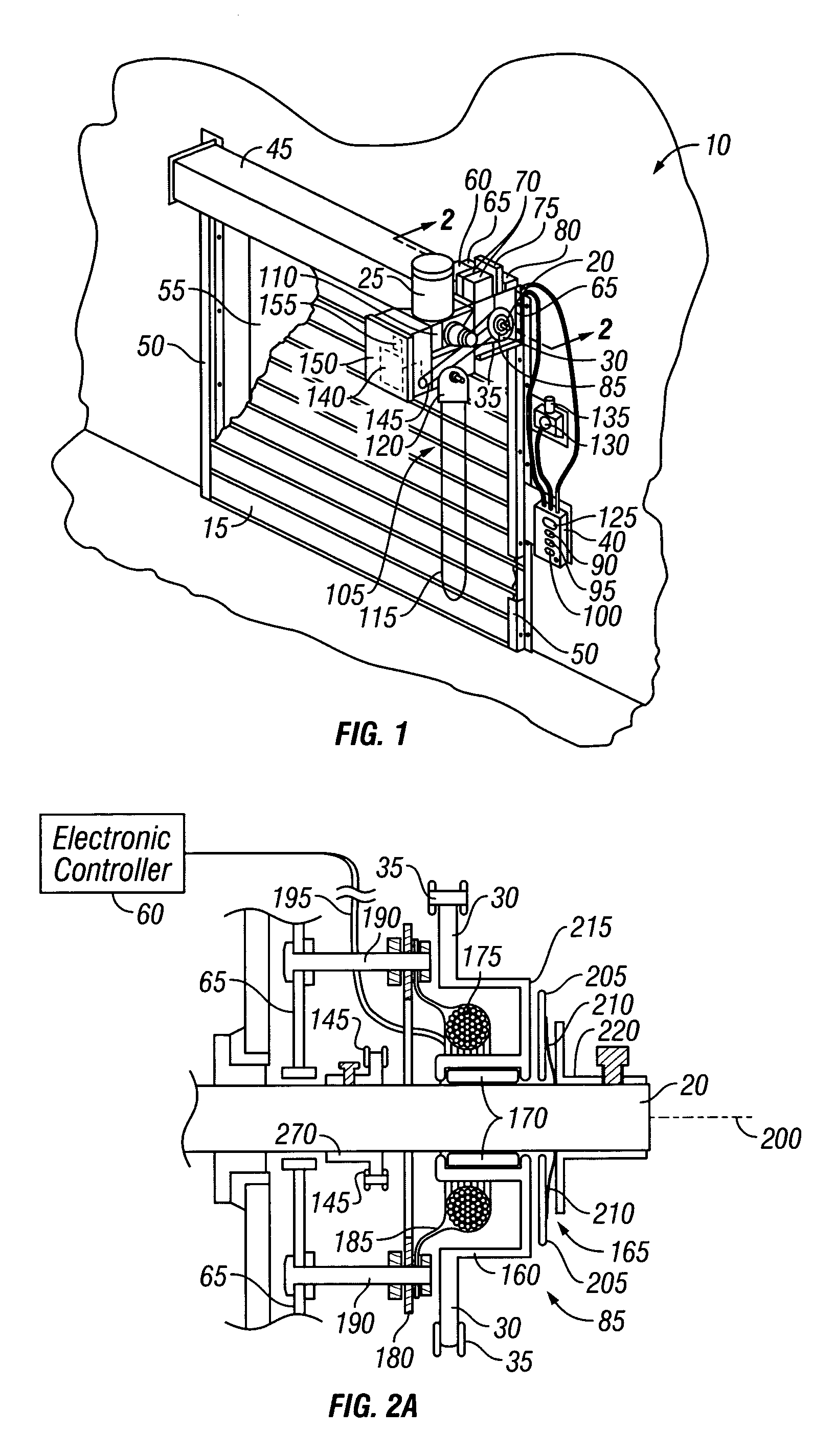[0012]One
advantage of the present invention is that the system may include a manual alarm switch. This manual alarm switch enables a user to manually test the system to assure that the system is functioning properly and is ready for an unexpected alarm condition. Furthermore, the system can be easily reset by the user. To reset the system, the user simply opens the door to its fully opened position. When the door reaches its fully opened position, a reset switch is actuated and sends a
signal to the controller. The controller resets the system by changing the state of the system from any alarm mode that was present previously to a regular operational mode.
[0013]While various aspects of fire door systems of the present invention have been described generally above, the clutch of such a system has particular features that advantageously provide for lowering of the door under conditions of loss of primary power and in the case where the hand
crank remains engaged during an alarm condition. The clutch may be connected to the secondary power source so that even if power is lost, the door can be shut in a controlled manner with the aid of the clutch. The clutch may have a rotor fixedly supported on the gear which in the present invention may be a
sprocket. Thus, the rotor and the
sprocket may be fixed together and may be adapted to be rotatively supported on the axle of the rollable door. The clutch may also have an armature including at least one spring supporting a flex plate. The armature also may have a mounting structure that fixedly supports the spring and flex plate on the axle. There may be a small gap between a face of the rotor and a face of the flex plate. The clutch may also have a coil that is supported within the rotor. The coil induces a
magnetic field that attracts the flex plate to the rotor against the bias of the spring. Thus, the flex plate can be magnetically and frictionally engaged with the rotor to prevent rotational movement between the flex plate and the rotor. In this engaged condition, the spring substantially rigidly supports the flex plate on the support structure. Therefore, when the clutch is in the engaged condition, the
sprocket is substantially rigid with the fire door axle and can hold or drive the axle.
[0014]For retrofit applications and for new installations, the clutch can be part of a larger fire door
movement control assembly. The fire door
movement control assembly may also include a mounting plate that is adapted for mounting the control
assembly on support structure for a fire door. The mounting plate may have a through opening sized and positioned to receive the fire door axle therethrough. The mounting plate may also have a mounting platform that supports the controller, which can be an
electronic controller, and other electrical components of the fire door movement assembly. This configuration of the clutch, mounting plate, controller, and other electrical components is very advantageous in
retrofitting to existing fire
doors as an
upgrade to those systems. In particular, it is to be understood that any existing drive mechanism including, for example, a motor, a gear box, etceteras, can be used in conjunction with the present invention as long as the drive mechanism is adequate for the weight of the fire door and the wiring is proper and modifiable. Thus, virtually any existing fire door can be upgraded and provided with the advantages of the present invention by
retrofitting the present invention to the existing fire door. It is to be noted that since the rotor rotates, the coil cannot easily be mounted on the rotor. Therefore, the fire door
movement control assembly may also include coil fastening elements in the form of standoffs that support the coil on the mounting plate.
[0015]Whereas systems of the past generally have the drive mechanisms and release mechanisms combined into an integral unit, the system of the present invention lends itself to providing the release mechanism together with the drive mechanism of a new installation or as an
upgrade of an existing fire door, which already has a drive mechanism. For upgrades to existing fire
doors, the old release mechanisms including fusible links and non-operator controllable lowering mechanisms can be removed and discarded. The release and lowering mechanisms of the present invention can thus replace the release and lowering mechanisms of the past.
[0016]The present invention also relates to a method of controlling a fire door system. Generally, a method of controlling a fire door system may include controlling the fire door by an
electronic controller during alarm conditions and non-alarm conditions. Accordingly, the fire door may be controlled by a motor during alarm conditions when a primary power source is on. The fire door may be controlled by a clutch during alarm conditions when the primary power source is off or when the system does not include a motor. In any case, the method may include the electronic controller receiving a
signal indicating one of the alarm conditions. In response to receiving the
signal, the electronic controller may initiate an audio and / or visual alert to inform persons of the alarm condition and to warn them that the fire door will be closing. It should be noted that the audio and / or visual alert can be any one of a variety of specific alerts corresponding to specific alarm events. Furthermore, the electronic controller may be configured to automatically provide a variety of audio and / or visual alerts in response to specific events whether they be alarm events or
time sequence events. The method may also include receiving any of a plurality signals from sensors in the system as has been discussed above. To this end, the method may include providing a variety of alerts and / or
time delays in response to specific corresponding input signals to the electronic controller.
[0017]An
advantage of the method is that the fire door system of the present invention does not require a specialist to come to the site of the fire door, test it, and reset it. A fire door associated with the present invention is easily tested and reset by an employee or facility owner. The system can be reset simply by removing an alarm condition. In some cases resetting the system may require the steps of removing an alarm condition and resetting the system. This can be achieved by simply opening the door after it has been lowered in an alarm condition. During testing or an actual emergency event, the end limits of motion are never lost during closure of the fire door with the present invention because the limits are connected directly to movement of the door. Thus, the fire door of the present invention need not remain inoperable while awaiting service from the specialist after an emergency event. That is, the fire door does not cause “down time” while awaiting a specialist to come re-engage the drive mechanism, reset the limits, reset the pulleys, replace the fusible links, and tie the release mechanism to a mounting device as required by systems of the past.
 Login to View More
Login to View More  Login to View More
Login to View More 


